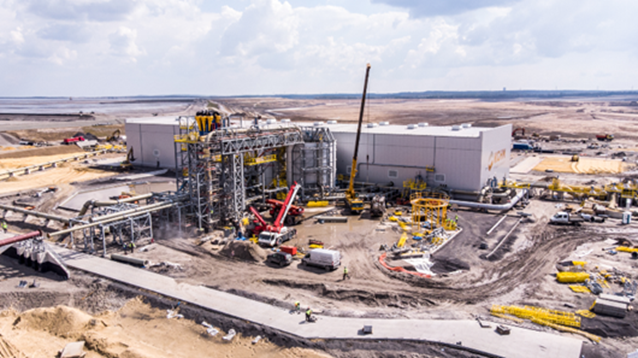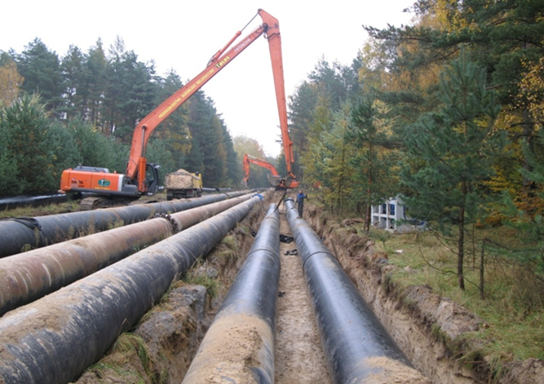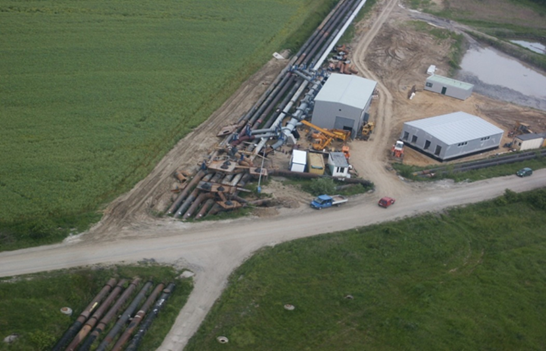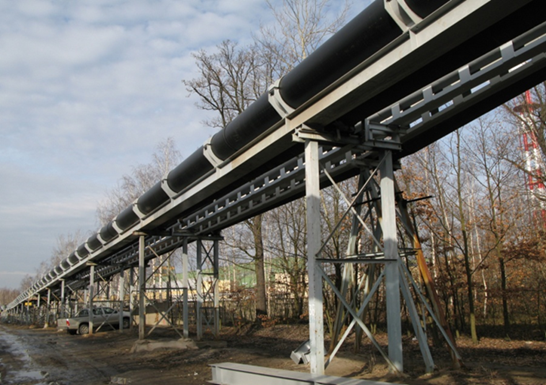- obtaining a decision approving the mining waste management program (Articles 8–11 of the Mining Waste Act),
- obtaining a permit to operate a tailings storage facility (Articles 14-17 and 19 of the Mining Waste Act),
- preparing a risk assessment study for a tailings storage facility (Article 10 of the Mining Waste Act),
- preparing an external emergency plan (Articles 19 and 37 of the Mining Waste Act),
- preparing an internal emergency plan (Article 36 of the Mining Waste Act),
- preparing a major accident prevention policy along with a safety management system implementing the policy (Article 36 of the Mining Waste Act),
- hiring a safety officer (Article 36(6) of the Mining Waste Act),
- hiring a facility manager qualified in waste management (Article 22 of the Mining Waste Act),
- in connection with the requirements of Article 32 of the Mining Waste Act, presenting a financial guarantee or its equivalent by the waste holder, on the terms specified in the Regulation of the Minister of the Environment of 11 February 2015 on the Financial Guarantee and its Equivalent for a Tailings Storage Facility (Journal of Laws, item 311),
- obtaining consent for the extraction of waste pursuant to the Waste Act (Article 18 of the Mining Waste Act)
- monitoring the facility (Article 27 of the Mining Waste Act).

Circular economy including waste management

Striving towards a circular economy is one of the priorities of the KGHM Polska Miedź Group.
The Group implements the roadmap published on 24 September 2019 for the development of a circular economy in Poland, in the form as presented in the diagram below:
Key elements of building a circular economy in KGHM Polska Miedź S.A. Include:
- innovation, strengthening of cooperation between the Company and academic sector, and consequently implementation of innovative solutions related to a circular economy,
- participating in the growth of the market for secondary metallic raw materials and increasing the share of such materials in production,
- minimizing the volume of post-production waste to residual waste levels,
- seeking and implementing solutions that allow utilization of waste storage sites as secondary deposits
Waste management in KGHM Polska Miedź S.A.
Waste is generated as a side effect of almost every industrial activity. The copper industry also generates huge amounts of post-industrial waste, since it requires multi-stage processing of ores to obtain useful final products.
The largest stream of waste is flotation tailings, which represent approximately 94% of the mining output, or approx. 28 million tonnes annually. This waste is created in the flotation process, in which the main volume of waste rock extracted together with the ore is removed. The next stage of the core production line creating the second largest volume of waste is the pyrometallurgical process, which produces approx. 1.1 million tonnes of smelter slag. The third largest stream of waste from the Company’s activity is sludge from the Energetyka Sp. z o.o. sewage treatment plant: approx. 100,000 tonnes/year. Other large waste streams include dust and sludge from flue gas dust removal systems – up to 50,000 tonnes/year. The amount of waste generated in technological processes makes waste management one of the key issues associated with copper production, with impacts that are not just environmental, but also economic, technical and organizational.

The waste produced in KGHM Polska Miedź S.A. is managed in accordance with the principles set out in the Act on Waste of 14 December 2012 (Journal of Laws of 2013, Item 21, as amended), according to which all activities should be planned, designed and carried out in a way that prevents the generation of waste or minimizes the amount of waste generated. Waste, whose generation cannot be avoided, is first subject to recovery and if it is impossible for technological, economic or environmental reasons, is disposed of. Waste is stored only if other means of disposal are not available.
The business of the Tailings Division in Rudna (existing within the KGHM Polska Miedź S.A. organizational structure) includes, in particular, the operation of the Żelazny Most Tailings Storage Facility with the Southern Quarter. The construction of the current Main Facility within the Żelazny Most Tailings Storage Facility began in 1974. It has been in continuous operation and simultaneous expansion since 1977.
Location of the Żelazny Most Tailings Storage Facility with the Southern Quarter
Geographically, the Żelazny Most Tailings Storage Facility is situated in a valley surrounded from the north, south and by the natural boundary of the Dalkowskie Hills in the upper catchment area of the Rudna River. On its northern side, the Southern Quarter is adjacent to the Main Facility, with hills surrounding it on all other sides.
The Żelazny Most Tailings Storage Facility is located in Dolnośląskie Voivodeship, in an area falling into the administrative boundaries of three municipalities: Rudna, Polkowice and Grębocice. Together with the Southern Quarter, it covers an area of approximately 2,100 hectares.
KGHM Polska Miedź S.A. in Lubin holds legal titles (mostly in the form of ownership and perpetual usufruct, but also leasehold) to the land occupied by the Żelazny Most Tailings Storage Facility with the Southern Quarter and their technological installations.
A support pillar has been established for the Żelazny Most Tailings Storage Facility with the Southern Quarter, approved by a decision of the Director of the Regional Mining Authority in Wrocław. No mining operations are conducted on the copper ore deposit located underneath the facility or in its immediate vicinity. Both the current and projected impact of mining operations is classified as a category 0 mining area, signifying only a minor degree of impact of mining operations on building structures on the surface. This situation will not change if the operating front is relocated into the territory of Rudna municipality within the Lubin-Małomice mining area, where no mining operations have been conducted to date.
Classification of the facility
Pursuant to Article 6(1)(1)(a) of the Mining Waste Act of 10 July 2008 (consolidated text: Journal of Laws of 2021, item 1972), the Żelazny Most Tailings Storage Facility with the Southern Quarter is classified as a category A facility, because its failed or improper operation may result in a major accident. Moreover, pursuant to §3(1) of the Regulation of the Minister of the Environment of 5 April 2011 on the Detailed Criteria for the Classification of Tailings Storage Facilities (Journal of Laws of 2011 No. 86, item 477), the facility in question fulfils one of the criteria listed in item 1, namely:
“The anticipated short-term or long-term consequences of an accident resulting from the lossof stability by a tailings storage facility, including any potential failure of mechanisms related to the design of such facility, or from the improper operation of such facility, may lead to any of the following:
- significant risk of the loss of life,
- serious threat to human health,
- serious threat to the natural environment”.
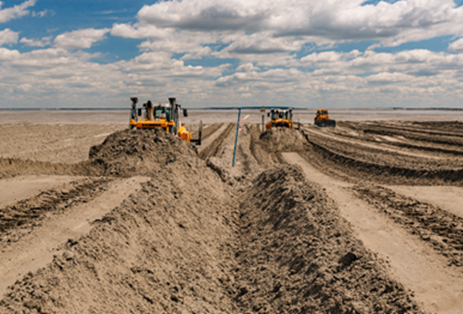
The Żelazny Most Tailings Storage Facility with the Southern Quarter is classified as suitable for the execution of projects that may always exert a significant impact on the natural environment, as enumerated in §2(1)(48) of the Regulation of the Council of Ministers of 10 September 2019 on Projects that May Exert a Significant Impact on the Natural Environment (Journal of Laws of 2019, item 1839), i.e. the category A tailings storage facilities referred to in the Mining Waste Act.
Pursuant to the Resolution of the Minister of the Environment of 20 April 2007 on the Technical Conditions to Be Fulfilled by Hydrotechnical Structures and Their Location (Journal of Laws No. 86 of 2007, item 579), the Żelazny Most Tailings Storage Facility with the Southern Quarter is classified as class 1 hydrotechnical structure. Its purpose is to dam up water continuously, it is situated on a non-rocky foundation, its damming height exceeds 20 m and its capacity is greater than 50 million m3.
The Żelazny Most Tailings Storage Facility with the Southern Quarter conducts waste management operations on tailings obtained as a result of the flotation enrichment of copper ores, code 01 03 81 Waste from flotation enrichment of non-ferrous metal ores other than those mentioned in 01 03 80, generated in three regions of the Concentrators Division in Polkowice of KGHM Polska Miedź S.A. in Lubin. These tailings are used in the construction of dams on subsequent levels and to seal the bottom of the facility, with the remaining portion neutralized through the storage process.
In 2021, 28,197,740 tonnes of code 01 03 81 waste was collected by the facility, of which:
- 18,046,553 tonnes was recovered in the R5 process (construction of dams in the facility and sealing of its bottom)
- 10,151,187.00 tonnes was neutralized through the D5 storage process.
The Żelazny Most Tailings Storage Facility is an upstream-downstream structure, comprising two parts: the existing Main Facility and the new Southern Quarter, surrounded by embankments (dams), where tailings are deposited inside the bowl using the “wet method”. The expansion of the Main Facility is conducted using the “upstream method” (i.e. without the need to encroach on any new areas), using tailings recovered from the flotation tailings stream to build up dams and seal the bottom of the basin. The Southern Quarter’s dams are built using the “downstream method”.
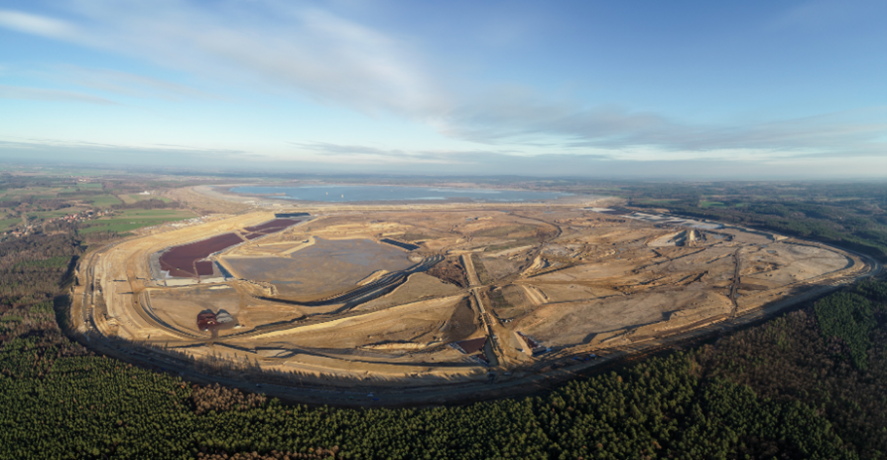
In 2021, the newly built Southern Quarter was commissioned (in the part covering the facility’s initial dams), and the Tailings Segregation and Compacting Station’s hydrocycloning technology was brought on-line as an element of the expansion and reconstruction of the Żelazny Most Tailings Storage Facility.
The Southern Quarter area is intended solely for the disposal of thickened waste, chiefly from the Tailings Segregation and Compacting Station, which is an element of the expansion and reconstruction of the Żelazny Most Tailings Storage Facility.
The crucial and indispensable components of the technical infrastructure located in the Żelazny Most Tailings Storage Facility with the Southern Quarter and the adjacent areas include:
- an installation for the distribution and disposal of flotation tailings, including central pumping stations located on the premises of individual Ore Enrichment Plants (Concentrators),
- auxiliary (supporting) pumping stations located, in succession, in the south-western part of the facility – pumping station H, in the northern part – two pumping stations: northern N and R, and in the south-eastern part – pumping station L,
- an installation for the collection of over-sediment water,
- draining installations:
- primary dam,
- annular,
- vertical,
- relieving,
- a drainage water removal system, including filtration water tanks,
- over-sediment water pumping stations,
- an over-sediment water treatment plant,
- technical monitoring system for the facility,
- a system preventing the occurance of dust of beaches and dams, including an installation for the storage of preparations binding the top layer of tailings,
- an environmental monitoring system on the premises of the facility and in the areas adjacent to the facility,
- an electrical substation,
- a Tailings Segregation and Compacting Station located on a portion of the Main Facility,
- the technological water pumping station “Damówka”
with installations – under construction, - an influx line “E” in the Southern Quarter,
- silting pumps (planned) in the Main Facility.
The activities described above require the use of the following pipelines (also mentioned above):
- for the transport of water, through which technological water is sent for production purposes to the Concentrators Division and any excess is discharged into the Odra River in Głogów,
- for the transport of sludge, through which flotation tailings are removed from three regions (Polkowice, Rudna and Lubin) of the Concentrators Division
The over-sediment water collected in the Żelazny Most Tailings Storage Facility is returned to the Ore Enrichment Plant and used in the flotation process, while the excess water is discharged into the Odra River in compliance with Decision No. WR.RUZ.421.71.2019.ER of 5 May 2021 issued by the Wrocław District Director of the Water Management Board of the State Water Management Authority granting a water permit for a water service involving the discharge of effluents into surface waters by applying an old filtering system, i.e. the discharge into the Odra River, using a discharging device comprising a new filtering system in the form of a 1420 mm distribution pipe (laid in the bottom of the Odra River on plot no. 58/8, cadastral district 0003, Wyspa Katedralna, city of Głogów) with two river-bank chambers. The decision came into force on 25 May 2021.
The over-sediment water drainage system from the facility comprises, among other elements, intake towers located in the Main Facility (within the basin), from which the water is moved through inflow pipes to two pumping stations located on the eastern (Kalinówka Pumping Station) and western (Tarnówek Pumping Station) sides of the facility.
Expansion of the facility
The design, build-up, expansion and operation of the Żelazny Most Tailings Storage Facility has been carried out in accordance with the principles of the so-called observational method, whereby a regular verification and updating of assumptions and design solutions is conducted based on observations, tests and measurements performed during the operation of the facility. The use of the observational method may result in amending the processes of design, build-up, expansion and operation of the facility.
In accordance with the principles of the adopted observational method, the decision on the potential build-up of the facility’s dam should be based on an interpretation of archival and current results of observations, measurements taken by control and measurement equipment and hydrogeological tests (updates of geological, engineering and geotechnical conditions). A verification and update of the design assumptions, based on the current interpretation of the said results of observations, tests and measurements, should be carried out for each 2.5 m of the superstructure of all sections of the facility’s dam. The application of this approach in the design process enables ongoing assessment of the situation and, if any security risk is identified in respect of the dam, it also enables the taking of appropriate technical measures to ensure that the safety level specified in the applicable technical and construction regulations is complied with.
The use of the observational method translates into a better and more effective distribution of funds, thereby improving the facility’s performance and significantly reducing the risk of making an error that would compromise the durability or perhaps even the safety of the structure.
Various types of control and measurement equipment are put to use for the purposes of making and recording current observations, including:
- geodetic measurement points,
- open piezometers,
- string piezometers,
- inclinometers,
- drainage and relief wells,
- horizontal drainage expenditure measurement points,
- flow measurement points in ditches,
- seismic positions,
- staff gauges.
Seismic monitoring is partly used from the network owned by the Mines. The Mines own some of the geodetic points, accelerometers or seismometers, and their tasks also include the taking of measurements and the maintenance of equipment.
The observational method requires the execution of various analyses and arrangements. The whole process involving the expansion of the facility is supervised directly by an extensive group of experts and scientists who take part in regular meetings (Construction Boards) to discuss all of the issues related to designing, monitoring and expanding the Żelazny Most Tailings Storage Facility.
Description of the existing situation – administrative decisions required by law
In connection with the requirements of Articles 28, 33(1) and 34(4) of the Construction Law of 7 July 1994 (consolidated text: Journal of Laws of 2021, item 2351, as amended), the construction/expansion of a hydrotechnical facility requires the investor to obtain a building permit.
Moreover, the construction of, for instance, new pipelines or new facilities, such as a pumping station and the Southern Quarter (built in stages), requires notification of the completion of construction work or obtaining an operating permit, pursuant to Article 54 or 55 of the Construction Law.
It should also be pointed out that the Main Facility, due to the specific nature of the continuous construction of an operating facility, does not require an operating permit.
Due to the requirements of Articles 71(2) and 72 of the Act on the Provision of Information on the Natural Environment and its Protection, Public Participation in Environmental Protection and Environmental Impact Assessments, before obtaining a decision on a building permit, a facility operating permit, a waste processing permit or a decision on a permit to operate a tailings storage facility, it is necessary to obtain an environmental impact decision. In the current factual and legal status, in compliance with Article 75(1)(4) of the Act on the Provision of Information on the Natural Environment and its Protection, Public Participation in Environmental Protection and Environmental Impact Assessments, the authority competent to issue an environmental impact decision is the municipality head. This requirement has been fulfilled.
- Decision No. PGOW 163/2018 of the Marshal of Dolnośląskie Voivodship approving the Mining Waste Management Program at KGHM Polska Miedź S.A., Tailings Division, in connection with the operation of the Żelazny Most Tailings Storage Facility with the Southern Quarter up to the elevation of the dams of 195 m above sea level,
- effective since 25 May 2021, Decision No. WR.RUZ.421.71.2019.ER of 5 May 2021 issued by the Wrocław District Director of the Water Management Board of the State Water Management Authority granting a water permit for a water service involving the discharge of sewage into surface waters by applying an old filtering system, i.e. the discharge into the Odra River, using a discharging device comprising a new filtering system in the form of a 1420 mm distribution pipe (laid in the bottom of the Odra River on plot no. 58/8, cadastral district 0003, Wyspa Katedralna, Głogów – town) with two river-bank chambers, approving effluents disposal through the existing installation until the new one is put into operation. By the power of this decision, Water Permit No. WR.RUZ.421.143.2019.ER of 11 February 2020 expired on the date when Decision No. WR.RUZ.421.71.2019.ER of 5 May 2021 became final,
- environmental decisions regarding the expansion of the Żelazny Most Tailings Storage Facility and the construction of the Southern Quarter, and the requirements of Article 27(1) of the Mining Waste Act of 10 July 2008 (consolidated text: Journal of Laws of 2021, item 1972) and the Regulation of the Minister of the Environment of 29 May 2014 on the Monitoring of a Tailings Storage Facility (Journal of Laws of 2014, item 875).
- measuring the volumes of precipitation in a weather monitoring station representative for the location of the Tailings Storage Facility,
- testing substances and measuring parameters in surface, runoff and ground waters from the list defined in the applicable water classification regulations,
- measuring ground water levels in observation wells,
- monitoring the subsidence of the Tailings Storage Facility’s surface based on the established survey benchmarks,
- measuring the volume of runoff wate.
In compliance with the applicable regulations and the provisions of environmental decisions, the following items are also monitored for the Żelazny Most Tailings Storage Facility:
- atmospheric air,
- soils and plants,
- the health of livestock,
- The health of children (under the age of 18),
- seismic monitoring.
- quantity of discharged effluents,
- quality of discharged effluents,
- quality of water in the Odra River.
In 2021, 27,730,418 m3 of excess water from the Żelazny Most Tailings Storage Facility was discharged into the Odra River.
The measurements of the Odra River water parameters are performed at 4 measuring points:
- Above the discharge at point 1L
- below the discharge at points 2L, 2N and 2P.
Due to the use of non-mining waste in the recovery process (e.g. for the construction of drainages or the construction of the facility’s side embankments), waste treatment in the Tailings Storage Facility requires a waste treatment permit. In compliance with Decision No. O 138/2015 (as amended) of 21 December 2015 issued by the Marshal of Dolnośląskie Voivodeship, ref. no. DOW-S-V.7244.59.2015.KB, journal entry no. 2520/12/2015 (as amended), granting a waste processing permit, in 2021 waste with the following codes was recovered in the R5 process:
- 521.16 tonnes of ex 10 01 01 Furnace slags
- 36,316.96 tonnes of ex 10 06 80 Granulated slags
- 160 tonnes of 17 01 01 Concrete waste and concrete debris from demolition and renovation work
In turn, during the construction of protective cover for the Southern Quarter’s drainage layer in 2021, 90,867.60 tonnes of waste code ex 10 06 80 Granulated slags was generated. The required environmental fees (air emission fee) and water fees (fixed fee and variable fee for discharging effluents into the Odra River) have been paid in a timely manner. The tasks and obligations arising from the applicable administrative decisions and regulations, including reporting duties, have been performed on an ongoing basis and in a timely manner.
Waste recovery
The possible directions and methods of recovery of waste generated by the Company’s installations depend on its material properties and the environmental aspects of its use.
In the material recovery of waste, waste is used in whole or partially in mining technologies, as a structural or building material, material for reclamation and for filling in post-mining voids, or as raw material for the production of abrasives. Metal-bearing waste is subject to processes to recover and recycle the metals and metal compounds it contains.
The following post-processing waste produced by the Company is recovered as structural and building materials:
- shaft slag from the Legnica Copper Smelter and Refinery and poured slag from the Głogów Copper Smelter and Refinery (with the addition of granulated slag) – used as high quality aggregates in road construction. This way, all the shaft slag and poured slag produced at KGHM is used. In 2021, 504.3 thousand tonnes of poured slag, 115.15 thousand tonnes of granulated slag for batching and 183.2 thousand tonnes of shaft slag were used for the production of aggregate.
- coarse-grained copper ore flotation tailings are used to build the embankments of the Żelazny Most Tailings Storage Facility and the Southern Quarter (6.77 million tonnes in 2021).
- fine-grained flotation tailings are used to seal the bottom of the Żelazny Most Tailings Storage Facility (11.28 million tonnes in 2021).
- granulated slag from the Głogów Copper Smelter and Refinery was used until 2021 to build the protective part of the drainage layer of the Southern Quarter at the Żelazny Most facility (in 2021 91,000 tonnes of granulated slag was used for this purpose); it is still used at the Main Facility for the construction of drainage layers in the waste massif and piers and embankments of the harbour (36.3 thousand tonnes in 2021).
In the mines of KGHM Polska Miedź S.A., hydraulic backfill is used to fill mined void (goafs). The main material used for this purpose is sand, but also granulated slag from the Głogów Copper Smelter and Refinery (in 2021 the Rudna Mine used nearly 6.5 thousand tonnes of slag for this purpose). Also, granulated slag of the appropriate fraction after drying is an excellent material for the production of abrasive materials used for blast cleaning of metal or concrete surfaces. In 2021, the Głogów Copper Smelter and Refinery supplied 94.8 thousand tonnes of slag for the production of abrasives.
The process of aggregate production based on the material supplied by KGHM’s smelters also permits a reduction of dust and gas emissions that would be released during the traditional process of aggregate creation. Over the past 10 years, KGHM Metraco S.A., a subsidiary of KGHM Polska Miedź S.A. has utilised approx. 10 million tonnes of slag, which means that it was not necessary to obtain this amount of raw material from natural deposits, and at the same time such a huge waste volume did not have to be stored. The aggregate produced by the KGHM Group was used for the execution of projects such as the construction of the S3, S5, S6 express roads, or the S11 express road, which is currently being built. Considerable volumes of material of this type are also used by local buyers executing infrastructure projects commissioned by local authorities. The main customers are the largest construction firms specialising in roadway construction.
The waste generated during copper production is a valuable metal-bearing raw material and therefore large volumes are either fully utilized or stored with a view to recovery in the future. Utilization of waste materials containing useful metals at levels justifying their recovery is an ordinary and obvious practice in the Company. They include waste from own installations (dust and sludge from waste gas dust removal installations) and metal scrap.
At the Legnica Copper Smelter and Refinery a highquality copper scrap processing line was built, as the first step for the planned Hybrid Smelter and Refinery in Legnica. Ultimately, it will be supplemented with the Scrap Trading Base, where the feedstock will be prepared for remelting at the Legnica Copper Smelter and Refinery and the Głogów Copper Smelter and Refinery. As part of the first stage in the Hybrid Smelter and Refinery in Legnica, copper scrap processing technology was employed using a Revolving-Casting-Refining (RCR) furnace. The RCR furnace enables the processing of copper scrap with average copper. content of 95% and the optimum capacity up to 90 thousand tonnes of anode copper per year. The total production of anode copper at the Legnica Copper Smelter and Refinery in 2021 amounted to 161.2 thousand tonnes, including 64.35 thousand tonnes from the RCR furnace. In 2021, in total 93 thousand tonnes of scrap were processed by the Legnica Copper Smelter and Refinery, which were thus returned to use in line with the idea of circular economy and did not become waste that would require disposal through landfilling.
The goal of the waste management function carried out by KGHM Polska Miedź S.A. is to further utilize waste from its own and third party core production lines in order to maximize the recovery of Cu and associated metals without impacting the natural environment. This approach suits the Circular Economy idea, in which one of the priorities is to reduce the mass of waste by using it as a raw material.
To sum up, we shall conclude that the circular economy concept is implemented in the KGHM Group in the following groups of actions:
- commercialisation of flotation waste towards recovering metal from such waste, as well as economic utilisation of rock forming minerals, as sealing material for the Żelazny Most Tailings Storage Facility, as filling in post-mining goafs, and material for applications in construction, road building and agriculture,
- development of the technology of recycling copper smelting in RCR furnace,
- closing the circulation of water in ore processing
- full reclamation of post-production areas,
- utilisation of heat energy contained in the mined deposit,
- development of the Company’s own research and development activity towards a circular economy,
- research and development within the Horizon Europe program towards a circular economy,
- development of the Company’s own investments towards a circular economy.
KGHM Polska Miedź S.A. has for many years conducted and will conduct a series of its own activities, non-forced by legal regulations, aimed at the implementation of a circular economy.
